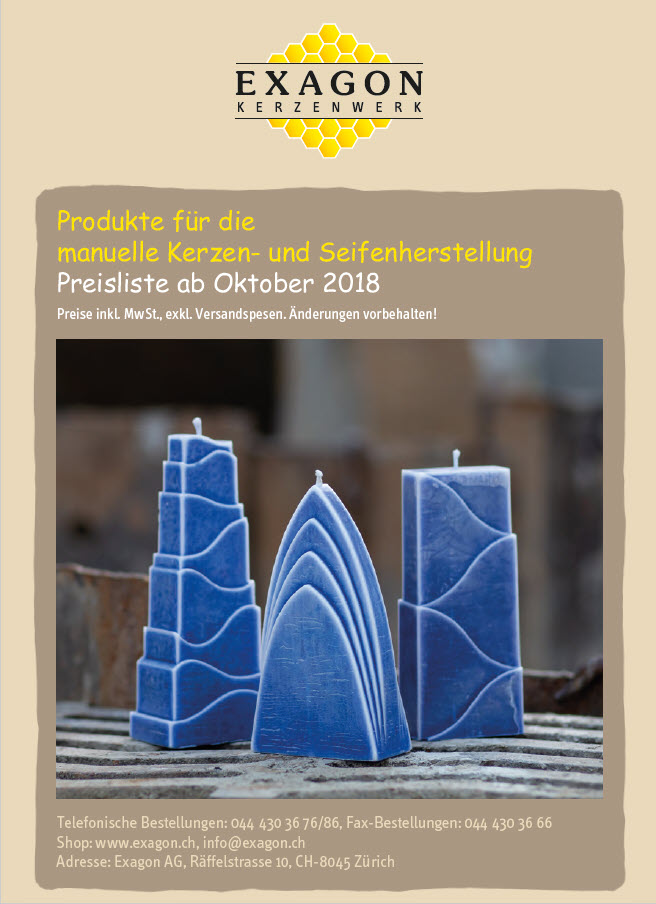Basket
Your basket is empty.
FAQs
Select from the following topics:
What is the difference between standard dyes and pigments?
How much wax dye should be added?
How can the colour shade be determined in liquid wax?
What should be borne in mind with neon dyes?
Can coloured candles cause staining?
What is the difference between standard dyes and pigments?
Standard dyes are for dyeing candles right through and pigments are for overdyeing/dip-dyeing untreated white candles.
Our standard dyes are aniline dyes (fat-soluble basis), which are ideally suited for colouring candles right through and have good burning properties. They can be readily stirred into the liquid wax mass using a metal or wooden rod. Standard dyes behave like "sugar in water" and are fully dissolved. Contrary to the case for pigments, however, standard dyes are not 100% lightfast (candles lose their colour somewhat over time).
Pigments are 100% lightfast and thus do not cause candles to lose their colour, even when they have been stored. They are, however, only suitable for colouring the surface of, or overdipping, white untreated candles or candles that have been dyed right through with aniline dyes. They must be mixed very thoroughly into the wax. These pigments behave like "sand in water" and do not dissolve fully. If a candle were to be coloured right through with a pigment, the high pigment component would obstruct the wick as it burned. In liquid wax, the pigment sinks to the bottom and must therefore always be stirred thoroughly before starting work.
For colouring modelling wax on the surface or right through, however, use should be made exclusively of pigments (but adding a smaller amount than usual, i.e. 0.5 g per 1 kg of wax).
How much wax dye should be added?
Standard dye (for colouring candles right through):
1-2 g per 1 kg wax, depending on the desired intensity and extent of colouring.
Neon dyes (for dyeing candles right through and overdyeing):
For colouring candles right through: max. 1 g per 1 kg wax / For overdyeing: 10 g per 1 kg wax
Pigment (for overdyeing):
1x dip-dyeing = 15g per 1 kg wax / 2x dip-dyeing = 10 g per 1 kg wax
For colouring modelling candle wax, only pigment should be used, adding 0.5 g per kg wax.
It is important to never add too much or to colour the wax excessively. Once wax is saturated with a colouring agent, the colour shade will not become more intense even if more colouring agent is added. Excess colouring agent cannot bond with the wax and will thus inevitably rub off on the immediate environment of the candle (e.g. the packaging or the supporting base, etc.). The following principle thus applies: the less colouring agent and hence the less foreign material in the candle, the less its burning will be impaired.
How can the colour shade be determined in liquid wax?
Put a small amount of liquid wax in a beaker of cold water. The wax will solidify in the water and you can see the colour shade. It should, however, be remembered that this colour shade will be slightly darker in the finished candle on account of the greater density of wax (especially with pure paraffin).
What should be borne in mind with neon dyes?
Neon dyes (Art. 41500, 41510 and 41520) are only suitable for colouring pure paraffin wax. Caution: adding an excessive amount of dye (more than 1g per 1 kg wax for colouring a candle right through) will impair the burning quality of the candle! Important: When colouring candles right through with neon dyes, select one wick thickness bigger than the specified thickness. Wax that has been coloured with neon dyes should be heated to 73°C for dipping candles and to 80°C for moulding candles. Neon dye will be destroyed if it is overheated for a prolonged period of time!
Can coloured candles cause staining?
The colour from candles in wax that contains too much colouring agent will inevitably rub off on the immediate environment (on the packaging or the supporting base, etc.). Because of their fat solubility, standard dyes tend to diffuse or transfer to immediately adjacent materials.













